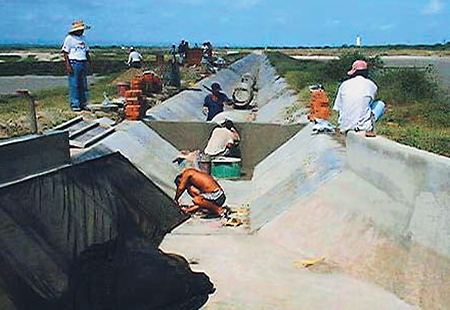Experiment produced good survival rates where the virus is established

Langostinera Isla Bella in northern Peru is a 185-ha shrimp farm that was seriously affected by WSSV. In late 1999, the decision was made to attack the problem by improving the environment rather than looking for a pharmaceutical solution. In a test of two production ponds, farm management decided to use an environmentally friendly oxidizing agent to treat the water, and aeration to sustain the improved environment.
As the farm staff investigated the options, it became obvious that water exchange would have to be limited and stocking densities increased to compensate for the higher cost of aeration and water treatment. Artificial substrates (AquaMats™, Meridian Aquatic Technology, LLC), were also chosen, based on the need to work with higher stocking densities.
The farm
Isla Bella is located 2 km from the ocean near Tumbes, Peru. The water intake is on a canal shared by several shrimp farms in the area. Water is pumped into a concrete basin and distributed by gravity to all ponds using an open concrete channel. In the test, a series of nets and screens were placed in the channel across the area where the water entered the ponds.
Water treatment
The water was treated with an oxidizing agent while in the channel. The unlined ponds required 3 percent additional water daily to compensate for evaporation and seepage. When the ponds next to the test ponds were filled, seepage dropped and daily exchange was reduced to 2 percent.
Pond setup and management
Two 1.5-ha ponds were used in the test. Pond 1 was stocked at 27 postlarvae (PLs) per square meter and pond 2 was stocked at 40 PLs per square meter. Group AquaGen in Cartagena, Colombia, supplied PL8-10 seedstock. Pond 1 used six 2-hp air injectors, and pond 2 used eight 2-hp air injectors. Pond 2 had AquaMats and pond 1 did not. Feeding was done using feeding trays. We used a local feed (Nicovita) and received technical support from this company throughout the test.
Pond monitoring
The test was conducted during the coldest time of the year in Peru. Pond records were maintained for dissolved oxygen, temperature, pH, salinity, bacteria count by type in the water and shrimp and water chemistry.
At approximately eight weeks, the first of two polymerase chain reaction (PCR) scans was done at the Center for Aquaculture Services in Ecuador. The second scan was done two to three weeks after the first. Both PCR scans came back positive, showing light infection. After the second scan, histology was performed, with negative results.
Production results
Pond 1 was harvested on day 85 after stocking, with 78.2 percent survival and animals averaging 8.67 grams. Pond 2 was harvested on day 95 after stocking, with 90.3 percent survival and animals averaging 9.36 grams. FCR in both ponds was about 1.1:1.
The relatively slow growth was attributed to the low prevailing temperatures. The decision to harvest was based on an observed increase in red coloration on shrimp tails and the activity of the shrimp in the ponds, indicating the potential for a WSSV outbreak.
Conclusion
This experiment produced very good survival rates in an area where WSSV is established and where other efforts have failed or had poor results. This was obviously not a controlled scientific study, as only two ponds were used and there were no control ponds. But it was an all-out effort against the WSSV problem that showed encouraging results.
Further work is still needed. However, it is obvious that improved control over the pond environment must be part of any WSSV-management strategy. We are grateful for the considerable technical support provided by Meridian Aquatic Technology, LLC.
(Editor’s Note: This article was originally published in the December 2000 print edition of the Global Aquaculture Advocate.)
Now that you've finished reading the article ...
… we hope you’ll consider supporting our mission to document the evolution of the global aquaculture industry and share our vast network of contributors’ expansive knowledge every week.
By becoming a Global Seafood Alliance member, you’re ensuring that all of the pre-competitive work we do through member benefits, resources and events can continue. Individual membership costs just $50 a year. GSA individual and corporate members receive complimentary access to a series of GOAL virtual events beginning in April. Join now.
Not a GSA member? Join us.
Author
-
Lee Lippert
Equipment & Technology, Inc.
Jacksonville, FL 32239 USA[116,101,110,46,101,110,111,97,105,100,101,109,64,116,114,112,108]
Tagged With
Related Posts

Health & Welfare
Alphavirus replicon particles potential method for WSSV vaccination of white shrimp
A study demonstrated that VP19 and VP28 white spot syndrome virus envelope proteins expressed by replicon particles provided protection against mortality due to WSSV in shrimp.

Health & Welfare
A comprehensive look at the Proficiency Test for farmed shrimp
The University of Arizona Aquaculture Pathology Laboratory has carried out the Proficiency Test (PT) since 2005, with 300-plus diagnostic laboratories participating while improving their capabilities in the diagnosis of several shrimp pathogens.

Intelligence
We can grow better shrimp, and in better ways
The recent Central American Aquaculture Symposium in Choluteca, Honduras, brought together more than 600 participants to discuss industry issues and perspectives. The focus was shrimp diseases and their impacts on production, as well as practical alternatives to face these issues and move forward.

Health & Welfare
Latin America FAO project establishes hatchery standards, info system
At a United Nations Food and Agriculture Organization (FAO) workshop 14 shrimp-producing countries discussed strategies for controlling shrimp diseases.


